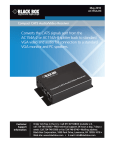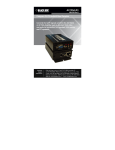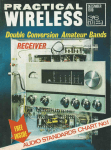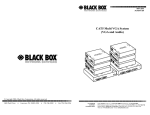Download Compact CAT5 Audio/Video Splitters
Transcript
December 2001 AC154A-2 AC154A-8 Compact CAT5 Audio/Video Splitters AC154A-2 2-Channel AC154A-8 8-Channel CUSTOMER SUPPORT INFORMATION Order toll-free in the U.S. 24 hours, 7 A.M. Monday to midnight Friday: 877-877-BBOX FREE technical support, 24 hours a day, 7 days a week: Call 724-746-5500 or fax 724-746-0746 Mail order: Black Box Corporation, 1000 Park Drive, Lawrence, PA 15055-1018 Web site: www.blackbox.com • E-mail: [email protected] Compact CAT5 Audio/Video Splitter TRADEMARKS USED IN THIS MANUAL BLACK BOX and its logo Corporation. are registered trademarks of Black Box Apple and Macintosh are registered trademarks of Apple Computer, Inc. IBM is a registered trademark of International Business Machines Corporation. SGI is a registered trademark of Silicon Graphics, Inc. Sun and Sun Microsystems are registered trademarks of Sun Microsystems, Inc. in the United States and other countries. Any other trademarks mentioned in this manual are acknowledged to be the property of the trademark owners. 1 Compact CAT5 Audio/Video Splitter FEDERAL COMMUNICATIONS COMMISSION AND CANADIAN DEPARTMENT OF COMMUNICATIONS RADIO FREQUENCY INTERFERENCE STATEMENTS This equipment generates, uses, and can radiate radio frequency energy and if not installed and used properly, that is, in strict accordance with the manufacturer’s instructions, may cause interference to radio communication. It has been tested and found to comply with the limits for a Class A computing device in accordance with the specifications in Subpart B of Part 15 of FCC rules, which are designed to provide reasonable protection against such interference when the equipment is operated in a commercial environment. Operation of this equipment in a residential area is likely to cause interference, in which case the user at his own expense will be required to take whatever measures may be necessary to correct the interference. Changes or modifications not expressly approved by the party responsible for compliance could void the user’s authority to operate the equipment. This digital apparatus does not exceed the Class A limits for radio noise emission from digital apparatus set out in the Radio Interference Regulation of the Canadian Department of Communications. Le présent appareil numérique n’émet pas de bruits radioélectriques dépassant les limites applicables aux appareils numériques de la classe A prescrites dans le Règlement sur le brouillage radioélectrique publié par le ministère des Communications du Canada. EUROPEAN UNION DECLARATION OF CONFORMITY This product complies with the requirements of the European EMC directive 89/336/EEC 2 Compact CAT5 Audio/Video Splitter Normas Oficiales Mexicanas (NOM) Electrical Safety Statement INSTRUCCIONES DE SEGURIDAD 1. Todas las instrucciones de seguridad y operación deberán ser leídas antes de que el aparato eléctrico sea operado. 2. Las instrucciones de seguridad y operación deberán ser guardadas para referencia futura. 3. Todas las advertencias en el aparato eléctrico y en sus instrucciones de operación deben ser respetadas. 4. Todas las instrucciones de operación y uso deben ser seguidas. 5. El aparato eléctrico no deberá ser usado cerca del agua—por ejemplo, cerca de la tina de baño, lavabo, sótano mojado o cerca de una alberca, etc. 6. El aparato eléctrico debe ser usado únicamente con carritos o pedestales que sean recomendados por el fabricante. 7. El aparato eléctrico debe ser montado a la pared o al techo sólo como sea recomendado por el fabricante. 8. Servicio—El usuario no debe intentar dar servicio al equipo eléctrico más allá a lo descrito en las instrucciones de operación. Todo otro servicio deberá ser referido a personal de servicio calificado. 9. El aparato eléctrico debe ser situado de tal manera que su posición no interfiera su uso. La colocación del aparato eléctrico sobre una cama, sofá, alfombra o superficie similar puede bloquea la ventilación, no se debe colocar en libreros o gabinetes que impidan el flujo de aire por los orificios de ventilación. 10. El equipo eléctrico deber ser situado fuera del alcance de fuentes de calor como radiadores, registros de calor, estufas u otros aparatos (incluyendo amplificadores) que producen calor. 3 Compact CAT5 Audio/Video Splitter 11. El aparato eléctrico deberá ser connectado a una fuente de poder sólo del tipo descrito en el instructivo de operación, o como se indique en el aparato. 12. Precaución debe ser tomada de tal manera que la tierra fisica y la polarización del equipo no sea eliminada. 13. Los cables de la fuente de poder deben ser guiados de tal manera que no sean pisados ni pellizcados por objetos colocados sobre o contra ellos, poniendo particular atención a los contactos y receptáculos donde salen del aparato. 14. El equipo eléctrico debe ser limpiado únicamente de acuerdo a las recomendaciones del fabricante. 15. En caso de existir, una antena externa deberá ser localizada lejos de las lineas de energia. 16. El cable de corriente deberá ser desconectado del cuando el equipo no sea usado por un largo periodo de tiempo. 17. Cuidado debe ser tomado de tal manera que objectos liquidos no sean derramados sobre la cubierta u orificios de ventilación. 18. Servicio por personal calificado deberá ser provisto cuando: A: El cable de poder o el contacto ha sido dañado; u B: Objectos han caído o líquido ha sido derramado dentro del aparato; o C: El aparato ha sido expuesto a la lluvia; o D: El aparato parece no operar normalmente o muestra un cambio en su desempeño; o E: El aparato ha sido tirado o su cubierta ha sido dañada. 4 Compact CAT5 Audio/Video Splitter Contents 1. Introduction ...............................................................................page 6 1.1 General ................................................................................page 6 1.2 Features ...............................................................................page 6 2. Installation .................................................................................page 7 3. Operation ...................................................................................page 9 4. Troubleshooting .......................................................................page 10 4.1 Problem Solving FAQ ........................................................page 10 4.2 Calling Black Box ..............................................................page 12 4.3 Shipping & Packaging ........................................................page 12 5. Specifications...........................................................................page 13 5 Compact CAT5 Audio/Video Splitter 1. Introduction 1.1 General The Models AC154A-2 and AC154A-8 are respectively 2 and 8channel UTP (CAT5) VGA video splitters (senders) with audio. The devices convert a PC's VGA and audio signals into a format that can be transmitted using a single inexpensive and commonly available Category-5 Unshielded Twisted Pair (UTP) cable with RJ45 connectors, which are used in most Local Area Networks. At the receiving (remote) end a matching receiver (Model AC155A – sold separately) is used to convert the UTP signal back to VGA and audio. The devices are housed in compact shielded enclosures and include connectors for the local monitor and speakers as well as multiple RJ45 connectors for connection to remote monitors. Included with the devices are: a small power adapter, and short video and audio cables for connection to the PC’s VGA and sound card’s outputs. The RJ45 outputs can drive CAT5 LAN cables to 500 feet (152 meters) with little to no degradation of video quality. A proprietary circuit in the receiver is used to compensate for signal losses in long cable runs. 1.2 Features 6 • Buffered video and pass-through audio outputs for connection to local monitor and speakers • Support resolutions up to 1280x1024 at any refresh rate • Rugged, Reliable, Compact size • No software required • Drive standard CAT5 cables to 500 feet • Transmit audio and video signals on one cable • Easily expandable by daisy-chaining the local in/out ports Compact CAT5 Audio/Video Splitter 2. Installation 1. Connect the VGA IN and AUDIO IN connectors of the AC154A to the computer's video and speaker ports using the supplied cables (see figures 2.1 and 2.2). Figure 2.1 Figure 2.2 2. Figure 2.3 Connect the local monitor and speakers to the device's VGA OUT and AUDIO OUT connectors respectively. (see Figure 2.3) NOTE To expand the number of outputs, use these ports to daisy chain to another AC154A’s VGA and audio inputs. Connect the local monitor and speakers to the last unit in the chain. 3. Connect the supplied power adapter to the power input connector on the unit. 7 Compact CAT5 Audio/Video Splitter 4. Using Category-5 cable connect one or more AC155A receivers to the unit's RJ45 outputs. The outputs are labeled PORT A and PORT B on the AC154A-2 or OUT 1 through OUT 8 on AC0154A-8. 5. Connect the remote monitor and speakers to the receiver unit and attach the power adapter to the receiver. Please refer to AC155A User’s Manual for further details. CAUTION Before plugging in your remote monitor, verify that the AC line is properly wired and that a protective ground (green) wire is established with NO potential difference between both the sender and receiver locations (The UTP splitter can tolerate up to 5 v peakto-peak ground noise between the two locations) . Failure to ensure good grounding can result in erratic operation and possible shock hazards with severe damage to your equipment. If an LCD is being used at the remote location, verify that the LCD ground is tied to power-line ground. If not, then ground the receiver unit by adding a ground strap (see troubleshooting section for more information). NOTICE Do not connect this unit to any LAN device such as network cards or hubs as this may damage the AC155A and/or the LAN device. Use EIA/TIA 568B standard straight-through patch wiring as shown below. Do not use crossover cables. EIA/TIA 568B WIRING STANDARD 8 PIN Wire Color 1 White w/ Orange Stripe 2 Orange 3 White w/Green Stripe 4 Blue 5 White w/Blue Stripe 6 Green 7 White w/Brown Stripe 8 Brown Compact CAT5 Audio/Video Splitter 3. Operation The video signal is fully terminated and buffered for the local video output connector. This means that terminating or plugging a local monitor is not necessary and this connector can be left open. The stereo audio input is passed through to the local audio output connector and the audio integrity is fully preserved. The transmitted audio in the CAT5 cable to the remote receiver is monaural. The audio outputs are “line-level” and powered speakers are required. Assuming that there are no major grounding or large EMI noise problems present, the video quality at the remote station depends on the length of the CAT5 cable, actual video resolution and refresh rate. The Model AC155A receiver employs proprietary user settable video compensation to enhance the image quality when long cables are used. In general at low and mid resolutions excellent image reproduction is provided at up to 500 feet. At high resolution and refresh rates perfect image reproduction can be achieved at shorter distances (see table 3.1 below). Using longer cables or higher resolution rates will still produce an image, but the reproduction quality will be reduced. Resolution Refresh Rate 60 Hz 75 Hz 85 Hz 640x480 500 ft 500 ft 500 ft 800x600 500 ft 500 ft 400 ft 1024x768 500 ft 400 ft 350 ft 1280x1024 500 ft 350 ft 300 ft Table 3.1 9 Compact CAT5 Audio/Video Splitter 4. Troubleshooting 4.1 Problem Solving FAQ 1. Fuzzy, blurry, or ghosting image at remote location If you have a stable image but it looks somewhat blurry (object or character edges are not sharp), make sure that you have set the receiver unit’s compensation switches correctly. Also check table 3.1 to see that you have not exceeded the maximum cable length recommendation. If you still have a fuzzy image, try reducing the refresh rate and/or resolution of the PC. You can also try CAT5e or higher with improved bandwidths (as long as the pairs are terminated as standard EIA/TIA 568B). If too much compensation is applied at the receiver, a bright and ghosting image may result. In this case try reducing the amount of compensation. 2. Image exhibits steady or rolling horizontal color “hum” bars This is usually an indication of improper grounding either at the sending end, the receiving end, or both. Verify that the AC line is properly wired and that a protective ground (green) wire is established with NO potential difference between both the sender and receiver locations. The UTP splitter can tolerate up to 5 v peak-to-peak ground noise between the two locations, but no more. The splitters and receivers rely on the equipment that are connected to them to establish a good ground reference. Most monitors and PC’s are well grounded to the power-line through their 3-Prong AC cord. However some Notebooks and LCD’s may be completely floating even when an external power supply is plugged into them. In this case, you must add a wire from the splitter or receiver to “earth” ground. The VGA and Audio connector shells and their respective hardware are all tied to unit’s internal ground and can be used to establish a connection to power-line ground. 10 Compact CAT5 Audio/Video Splitter 3. Shaking image or periodically blanking monitor Although CAT5 cable uses twisted pairs to transmit the signals from the splitter to the receivers to reduce the amount of EMI coupled noise from other external sources, a strong electromagnetic noise field can cause instability in the signal. Usual sources of this form of noise coupling are high current AC lines or other high-density data and/or control cables that run adjacent to and parallel with a substantial length of the CAT5 cable. To eliminate this, either place a distance between the CAT5 cables from the splitter and the interfering source, or use shielded CAT5 cables. Note that separating the CAT5 cable from the EMI source by a few inches is often sufficient to eliminate this problem. 4. The PC does not recognize a Plug-and-Play monitor If the PC’s Operating System is setup to detect a plug-and-play monitor (usually in Display Properties Advanced Settings), it may have trouble finding a monitor if no local monitor is hooked up to the splitter. Only the ID information of the local monitor is passed to the PC. If the PC does not produce an image due to this, either connect a monitor to the local VGA output port, or disable the plug-and-play monitor detection in the PC’s operating system. 5. Faint shadows or ghosts at the remote monitor Your splitter has multiple RJ45 output connectors. When a long CAT5 cable is plugged in any of the outputs, the unit expects a receiver unit at the far end for proper termination. Therefore it is a good idea to unplug the un-terminated CAT5 cables from the splitter unit. Please refer to item 1 above for other possible causes. 11 Compact CAT5 Audio/Video Splitter 6. Poor audio quality at the receiving end Only use powered speakers with the splitter and receivers. It is also good practice to set the audio level (volume) output of the PC about 1/2 to 2/3 from the maximum and use the volume knob of the speakers to adjust the volume to the desired level. A low volume signal output from the PC reduces the signal-to-noise (S/N) ratio, whereas too high output amplitude can cause saturation and clipping to occur. 7. Substituting power supplies The splitters rely on the AC power adapters that are supplied with them. The adapters generate a floating 12 v DC power for the unit. If you intend to use a different external DC power that is referenced to ground, the splitters will not function properly. 4.2 Calling Black Box If you determine that your splitter is malfunctioning, do not attempt to repair the unit. Contact Black Box Tech. Support at 724-746-5500. Before you do, make a record of the history of the problem. We will be able to provide more efficient and accurate assistance if you have a complete description, including: • The nature and duration of the problem; • The components involved in the problem—that is, what type of cable, makes and models of computers and monitors, etc. • The results of any testing you’ve already done. 4.3 Shipping and Packaging If you need to transport or ship your Splitter: • Package it carefully. We recommend that you use the original container. • Before you ship the unit back to Black Box for repair or return, contact us to get a Return Authorization (RA) number. 12 Compact CAT5 Audio/Video Splitter 5. Specifications Compliance CE; FCC Part 15 Subpart B Class A, IC Class Standards VGA, SVGA, or XGA video Interfaces Video: VGA; CAT5: Non-Standard Supported Video Types VGA through XGA, RGBS, or RGsB (sync on green”) Resolution & Refresh Rate Up to 1280 x 1024 non-interlaced at up to 85 Hz Bandwidth Video: DC to 250 MHz, Audio: 20 Hz to 10 KHz Video Level 0.7 volts peak-to-peak Audio Transmission Local output: Pass-Through Stereo, Remote: Mono Maximum Distance Connectors Maximum Altitude Up to 500 ft. (152 meters) – See table 3.1 for details HD15 female for video input and output 3.5 mm Mini-Stereo for audio input and output RJ45 for CAT5 A/V outputs 10,000 ft. (3048 m) Temperature Tolerance Operating: 32 to 122°F (0 to 50°C); Storage: –40 to +185°F (–40 to +85°C) Humidity Up to 95% non-condensing Enclosure Steel 13 Compact CAT5 Audio/Video Splitter MTBF 300,000 hours (calculated estimate) Power From utility-power (mains) outlet, through included external power adapters. Output Voltage: 12v DC Center-Positive, floating (do not substitute any other external power supply). Power supply current requirements: 300 ma minimum for AC154A-2, or 500 ma minimum for AC154A-8. Size AC154A-2 : 1.22"H x 4.86"W x 2.60"D AC154A-8 : 1.32"H x 7.58"W x 3.88"D (AC154-8 has 2 L-shaped mounting ears that protrude 0.88” beyond the main box on each side). 4 mounting holes are present on a rectangular pattern of 8.62" x 2.63" Shipping Weight 14 AC154A-2 : 1.8 lb AC154A-8 : 3.0 lb NOTES 16 © Copyright 2001. Black Box Corporation. All rights reserved. 1000 Park Drive Lawrence, PA 15055-1018 724-746-5500 Fax 724-746-0746































